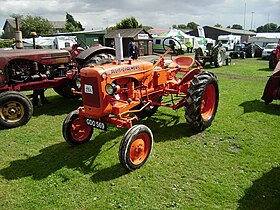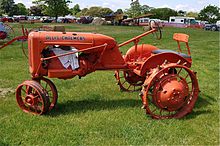This is an old revision of this page, as edited by Knife-in-the-drawer (talk | contribs) at 11:54, 16 May 2015 (→References: Checkwiki error fix #70. ISBN with wrong length). The present address (URL) is a permanent link to this revision, which may differ significantly from the current revision.
Revision as of 11:54, 16 May 2015 by Knife-in-the-drawer (talk | contribs) (→References: Checkwiki error fix #70. ISBN with wrong length)(diff) ← Previous revision | Latest revision (diff) | Newer revision → (diff) Motor vehicle| Allis-Chalmers Model B | |
|---|---|
 An Allis-Chalmers Model B at a UK steam show An Allis-Chalmers Model B at a UK steam show | |
| Overview | |
| Type | Agricultural tractor |
| Manufacturer | Allis-Chalmers |
| Production | 1938-1957 |
| Powertrain | |
| Propulsion | Wheels |
| Dimensions | |
| Length | 110.25 in (280.0 cm) |
| Width | 52.7 in (134 cm) |
| Height | 76.75 in (194.9 cm) |
| Curb weight | 2,060 lb (930 kg) |




The Allis-Chalmers model B was a tractor produced by the Allis-Chalmers Manufacturing company from 1937 to 1957. With over 125,000 units produced, the model B became one of the best selling tractors for Allis-Chalmers and most loved tractors of its time. Known best for its versatility and adaptability, the model B was also one of the longest production tractors for Allis-Chalmers as well. Over the years of production the B came in several different variations including the Asparagus B, Potato Special, and the IB industrial tractor. The Model B was designed by Brooks Stevens an industrial designer and graphic designer.
History of the B
In the early thirties, Allis-Chalmers tractor division manager Harry Merritt studied the farm census figures and discovered that of the nearly seven million farms in America, some four million were of 100 acres (0.40 km) or less. Furthermore, the million or so tractors at work on American farms were nearly all on the larger ones. Although the Fordson tractor and then the first-generation row-crop tractors, including the Farmall, Allis-Chalmers's own Model WC, and others, had been gaining significant market penetration and making mechanised agriculture ever more popular, Merritt concluded that there was a need for four million small, inexpensive tractors to fill the needs of the small farmers still using horses. Merritt set out to build the tractor that would finally put the horse out to pasture.
The Model B was Allis-Chalmers' second-generation row-crop tractor. It was small, light, and versatile. The combination of an excellent tractor and effective marketing help the B to become a commercial success. Allis's marketing department had experience with such challenges as convincing doubting farmer the benefits of pneumatic tires. Early sales literature for the Allis Chalmers B was devoted to convincing the farmer that the new B required less work to maintain than horses. It was also armed with government-supplied facts and statistics along with Allis's own research proving that the new B cost less to both buy and operate than horses.
The B would not remain the smallest row-crop in Allis's lineup. From 1948 to 1955 it produced the Model G, with only about 10 draw bar horsepower.
See also
References
- The Allis Chalmers Story. C.H Wendel ISBN 978-0-87349-927-9
- Antique Power Magazine July/August 1996
- Allis Chalmers Model B, Antiquefarming.com
| Allis-Chalmers | |
|---|---|
| Subsidiaries | |
| Former subsidiaries | |
| Former brands | |
| Successors | |
| Products | |
| Related articles | |